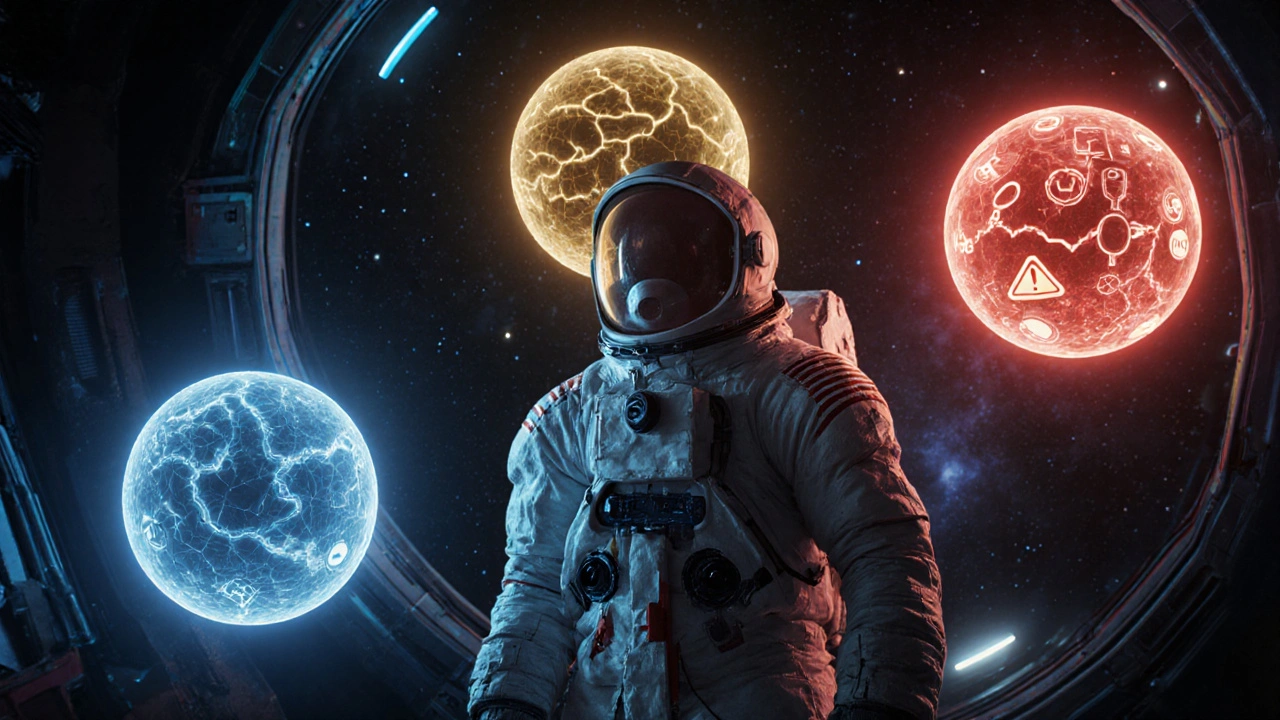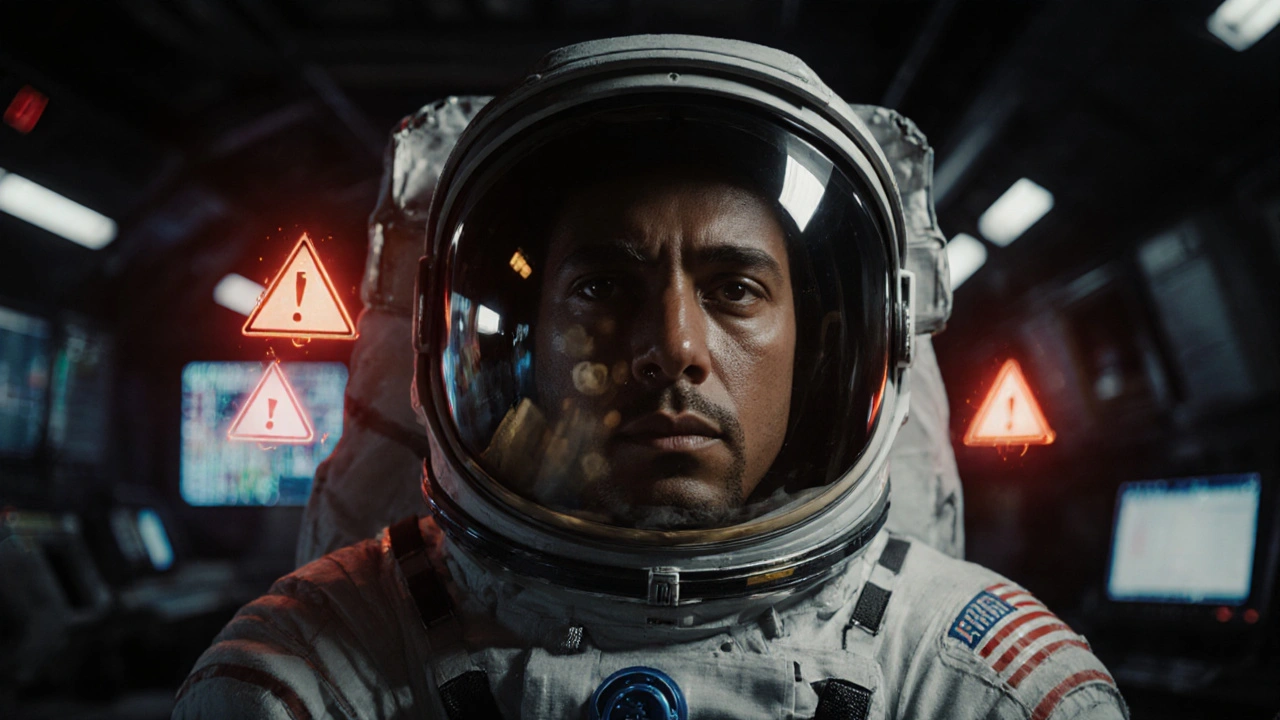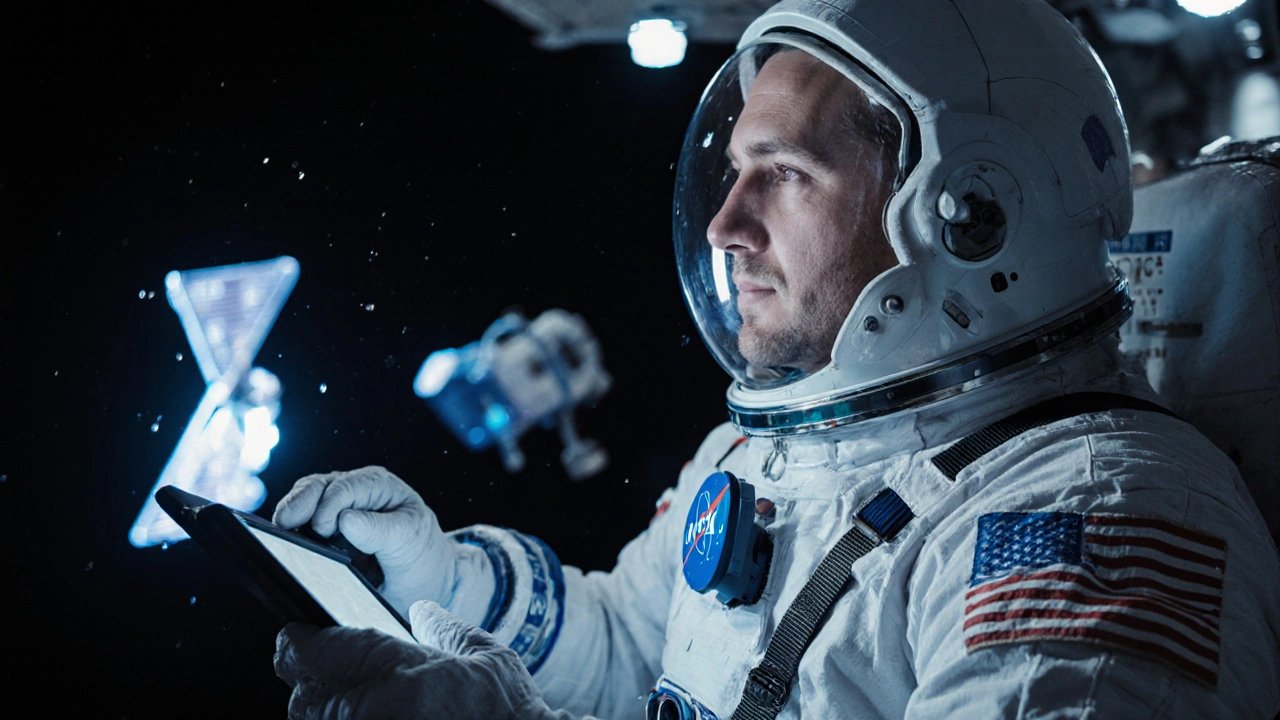Why Cognitive Performance Matters in Space
When you’re floating 400 kilometers above Earth, a single mistake can cost lives. Astronauts don’t just need physical strength-they need razor-sharp focus, perfect memory, and the ability to think clearly under pressure. That’s why cognitive performance isn’t just a buzzword in space missions-it’s a survival requirement.
On the International Space Station (ISS), astronauts juggle dozens of high-stakes tasks every day: repairing life support systems, analyzing data from experiments, communicating with mission control, and preparing for spacewalks. Each task demands mental resources. Too little mental engagement, and they miss subtle warning signs. Too much, and their decision-making breaks down. The goal isn’t to push them to their limits-it’s to keep them in the sweet spot where performance is steady, accurate, and reliable.
The Three Zones of Cognitive Workload
Cognitive workload isn’t linear. It doesn’t just get worse as tasks pile up. NASA’s research breaks it into three distinct zones:
- Low Workload Zone: When tasks are too simple or repetitive, astronauts become bored. Attention drifts. Reaction times slow. This isn’t laziness-it’s the brain disengaging from under-stimulation. In space, where boredom can last for hours, this is dangerous.
- Optimal Performance Zone: This is the goal. Mental effort matches task demands. Astronauts stay alert, make quick decisions, and recover fast from distractions. This zone keeps missions running smoothly.
- High Workload Zone: When too many tasks hit at once-say, an alarm sounds while they’re troubleshooting a leak and talking to ground control-the brain hits a wall. Errors spike. Memory falters. NASA calls this the "Red Line." Crossing it increases error risk by 27%, according to their 2022 modeling study.
There’s no universal formula for staying in the optimal zone. What’s manageable for one astronaut might overload another. That’s why personalization is key.
How NASA Tracks Cognitive Health in Real Time
NASA doesn’t guess whether an astronaut is mentally fatigued-they measure it. Every week, crew members take three short tests:
- Psychomotor Vigilance Test (PVT-B): A 5-minute reaction time test. Slower responses = declining alertness.
- Digit Symbol Substitution Test (DSST): How fast can you match symbols to numbers? It measures processing speed and attention.
- 2-Back Test (F2B): A memory challenge where you recall what you saw two steps ago. It tracks visual working memory.
These aren’t just busywork. Data from these tests flows to flight surgeons every 48 hours. If scores drop below pre-flight baselines, the team adjusts schedules, delays non-critical tasks, or schedules extra rest. Since 2024, NASA has also started using the Cognitive Workload Assessment System (CWAS), which tracks eye movements and brainwave patterns during critical operations. It’s like a real-time dashboard for mental fatigue.

What Drains an Astronaut’s Mental Energy?
It’s not just workload. Five big factors shape how tired an astronaut’s brain gets:
- Task complexity: Fixing a broken water recycler while floating in zero-G is harder than doing the same thing on Earth.
- Individual differences: Some astronauts stay sharp for months. Others struggle after 30 days. Genetics, sleep habits, and stress resilience all play a role.
- Sleep disruption: NASA’s Dr. David Dinges found that sleep loss is the #1 cause of cognitive decline in space. Even 30 minutes less sleep per night reduces reaction speed by 12-15%.
- Environment: Microgravity, radiation, and constant noise from life support systems quietly drain mental energy.
- Task stacking: Doing two complex tasks back-to-back-like a spacewalk followed by a science report-is worse than doing them separately.
One surprising finding? Astronauts often report feeling fine-even when their test scores show clear decline. They don’t always recognize when they’re in danger of hitting the Red Line.
Space Fog and the First 30 Days
Many astronauts describe "space fog"-a hazy, slow feeling in their mind during the first two weeks in orbit. Short-term memory slips. They forget where they put tools. They misremember instructions. It’s not panic. It’s adaptation.
According to NASA’s 2020 Astro Perspective report, this is the most common complaint during long missions. The brain is adjusting to new sensory inputs: no up or down, fluids shifting in the skull, constant background hum. Most astronauts recover by day 30. But for 63% of them, slowed processing speed and memory issues linger into post-flight recovery.
What’s odd? Self-reported sleep quality doesn’t match test results. Some astronauts say they slept well-but their PVT-B scores say otherwise. That means you can’t trust how astronauts feel. You have to measure.
Training That Builds Mental Resilience
Astronauts don’t just learn how to fly rockets-they train their brains for chaos. Before launch, they complete over 1,200 hours of simulations. These aren’t simple drills. They’re designed to overwhelm.
One scenario: A fire alarm blares. Oxygen levels drop. A robotic arm malfunctions. The astronaut has to prioritize, communicate, and act-all while being monitored by mission control and a camera. After repeating these high-pressure scenarios dozens of times, they learn to recognize their own warning signs: a racing heart, tunnel vision, or the urge to rush.
They also learn to use countermeasures:
- Strategic napping: A 26-45 minute nap improves cognitive performance by 34%.
- Blue-enriched lighting: 150 lux of blue light during work hours boosts alertness by simulating daylight.
- Task scheduling: High-focus tasks are grouped in the morning. Low-focus tasks (like data entry) happen later.
It takes about 18 months of training to build this kind of mental resilience. And even then, it’s personal. One astronaut might thrive on a packed schedule. Another needs quiet time to reset.

What Happens on a Mars Mission?
ISS missions last 6 months. Mars missions will take 2-3 years. That’s a whole new level of challenge.
Current research shows that cognitive performance stays stable during 6-month ISS flights-but that doesn’t mean it’ll hold up longer. NASA’s 2024 Cognitive Task Analysis predicts a 18-22% decline in performance during the 6-9 month transit to Mars. Why? Isolation. Delayed communication (up to 20 minutes each way). No chance of quick rescue. Constant radiation exposure.
Special risks emerge on the Martian surface:
- Attentional tunneling: Focusing so hard on one task (like drilling a sample) that you miss a critical system alert.
- Plan continuation bias: Keeping going with a plan even when it’s failing-because changing course feels like failure.
NASA is already testing AI-driven tools that predict when an astronaut is approaching overload. By 2026, these systems will be live on Artemis III lunar missions. By 2030, they’ll be essential for Mars.
The Bigger Picture: Why This Matters Beyond Space
This isn’t just about astronauts. The same principles apply to surgeons, pilots, emergency responders, and even truck drivers working 16-hour shifts. Charlesworth Human Performance has already adapted NASA’s models for hospitals and aviation.
What we’ve learned in space is simple but powerful: human performance isn’t about pushing harder. It’s about working smarter. Monitoring mental state. Respecting limits. Building systems that protect the brain as much as the body.
For spaceflight, this means better missions. For Earth, it could mean fewer medical errors, fewer plane crashes, and safer workplaces.
Do astronauts really lose cognitive function in space?
It depends. For 6-month ISS missions, most astronauts show stable overall cognitive performance. But 11.8% of test scores fall below normal ranges, especially in processing speed and memory. These dips are often temporary, but they’re real. Longer missions-like those to Mars-are expected to cause more significant declines. The key is monitoring and adjusting before performance drops too far.
What’s the biggest threat to an astronaut’s mental focus?
Sleep loss. Studies show that even small reductions in sleep-like 30 minutes less per night-cause a 12-15% drop in reaction time. In space, where every second counts, that’s enough to miss a critical alert. That’s why NASA prioritizes sleep hygiene, lighting, and scheduled naps over other interventions.
How do astronauts know when they’re mentally overloaded?
They often don’t. Sixty-eight percent of astronauts in NASA’s 2024 study said they struggled to self-assess their mental state. That’s why objective tools like the PVT-B and CWAS are critical. You can’t rely on how someone feels-you need hard data.
Is cognitive workload worse in microgravity?
Not directly. Microgravity doesn’t hurt cognition-it adds complexity. Simple tasks become harder: grabbing a tool, reading a screen, or even walking to the next module. The brain has to work harder to adapt. Combine that with sleep disruption and radiation, and mental load increases. It’s the combination, not gravity itself, that’s the problem.
Are there tools to predict when an astronaut will crash mentally?
Yes. NASA’s Cognitive Workload Assessment System (CWAS), launched in October 2024, uses eye-tracking and EEG to detect early signs of overload during critical tasks. By 2026, AI models will predict cognitive decline hours in advance, letting mission control adjust schedules before errors happen. This tech is already being tested on the ISS.
What’s Next for Astronaut Mental Health?
The future of cognitive workload management is personal. NASA’s roadmap aims to double funding for individualized training by 2027. That means:
- Customized sleep and lighting plans based on each astronaut’s biology.
- AI coaches that give real-time feedback during simulations.
- Automated psychotherapy tools to help with stress and isolation.
- Pre-flight brain scans to identify who’s most vulnerable to mental fatigue.
The goal isn’t to make astronauts superhuman. It’s to make sure they stay human-sharp, focused, and safe-no matter how far from Earth they go.


12 Responses
NASA's got this down to a science. The PVT-B and DSST aren't just tests-they're lifelines. I've seen pilots crash from sleep debt. Same damn thing. Just replace cockpit with ISS. The brain doesn't care where you are-only if it's rested.
Let me tell you something about space fog-it's not some poetic metaphor, it's the brain screaming for oxygen in a world where gravity doesn't care if you're alive or not. You think your phone drains your focus? Try juggling a leaky water recycler while your inner ear thinks you're upside down and mission control is yelling in your headset about a CO2 spike. And don't even get me started on the blue lights-those things are like a neon sign screaming 'YOU ARE A LAB RAT' 24/7. They're not helping you stay alert-they're just making you feel like a goddamn LED bulb with a pulse.
This is actually one of the most elegant human factors studies I've ever seen. It's not about making astronauts tougher-it's about designing systems that respect the fragility of the human mind. The fact that they track eye movements and EEG in real time? Genius. We do this in surgery rooms now too. The parallels between space and ICU are terrifyingly beautiful. We just don't talk about it enough.
Sleep loss is the real enemy.
The Red Line is a useful fiction. The brain doesn't have lines it has thresholds and the thresholds shift with fatigue stress and the quiet hum of machines that never stop. We treat cognition like a battery when it's more like a tide. You can't measure the tide with a ruler you can only feel its pull
Wait-so NASA is using eye-tracking and EEG to monitor astronauts’ brains… but they’re still sending them to Mars??!! Who’s really in charge here? Are we sure they’re not just testing mind-control tech under the guise of 'space safety'? I mean, if they can track your attention down to the millisecond, what’s stopping them from *influencing* it? And why is no one talking about the radiation-induced neural degradation? They’re calling it 'space fog' like it’s a seasonal allergy! This is a cover-up. They know the brain decays faster than they admit. And the AI 'coaches'? That’s not therapy-that’s behavioral conditioning. You’re not preparing for Mars-you’re preparing for a hive mind.
I just find it so irresponsible that we're sending humans to Mars with cognitive decline predicted to hit 20% during transit, and yet we're still not mandating mandatory neurochemical support. Where's the ethical oversight? We wouldn't let a trucker drive 16 hours without a nap-why are we letting astronauts risk their minds for national prestige? This isn't exploration-it's sacrificial tourism. And the fact that they're calling it 'personalized training' just makes it worse. You're not giving people tools-you're making them responsible for their own breakdowns. That's not science. That's negligence dressed up in a spacesuit.
I’ve done shift work in hospitals. This is exactly the same. The PVT-B is the new vital sign. You don’t wait for someone to say 'I’m tired'-you measure it. The fact that astronauts don’t realize they’re crashing? That’s the most human part of all. We all think we’re fine until we’re not. This isn’t space stuff-it’s life stuff. And we ignore it on Earth because we’re too proud to admit we’re not machines.
The most profound insight here isn't the tech-it's the humility. NASA isn't trying to make astronauts superhuman. They're trying to keep them human. That’s rare. In a world obsessed with optimization and peak performance, this is a quiet rebellion: the idea that the mind needs rest, not just rigor. It’s not about pushing further-it’s about knowing when to pause. And that’s a lesson Earth desperately needs to learn.
Let’s be honest-this whole thing is a PR exercise wrapped in data. You think these tests are for the astronauts’ benefit? No. They’re for the taxpayers. NASA needs to show Congress they’re not wasting money on 'space psychology.' The real issue? They’re using astronauts as guinea pigs for a system that will never be implemented on Earth because it’s too expensive. And don’t get me started on the 'personalized lighting'-that’s just corporate jargon for 'we gave you a fancy LED bulb and called it science.'
The integration of cognitive workload assessment into operational protocols represents a paradigm shift in human performance management. The empirical validation of the three-zone model, coupled with real-time neurophysiological telemetry, establishes a robust framework for proactive risk mitigation. It is imperative that this methodology be adopted across all high-stakes domains, including aviation, emergency medicine, and nuclear operations, to prevent catastrophic human error. The data is unequivocal: cognitive resilience is not innate-it is engineered.
You know what’s really going on? They’re not worried about astronauts getting tired. They’re worried about them thinking too much. Why else would they track eye movements and brainwaves? They don’t want astronauts questioning the mission. They don’t want them wondering why they’re stuck in a metal can with no escape. That’s why they’re feeding them blue light and scheduled naps-it’s not to keep them sharp, it’s to keep them docile. And the AI coaches? They’re not helping them think-they’re training them to stop thinking. This isn’t science. It’s control.